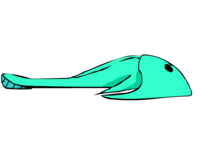Agnatha
Fossil range: Early
Cambrian - Recent |

|
|
Scientific classification |
| Kingdom: |
Animalia
|
| Phylum: |
Chordata
|
| Subphylum: |
Vertebrata
|
| Superclass: |
Agnatha
|
|
| Groups |
Myxini (hagfish)
Hyperoartia
-
Petromyzontidae (lampreys)
Pteraspidomorphi
Thelodonti
Anaspida
Cephalaspidomorphi
- Galeaspida
Pituriaspida
Osteostraci
|
Agnatha (Greek,
"no jaws") is a
paraphyletic superclass of jawless fish in the phylum
Chordata, subphylum
Vertebrata. There are two extant groups of jawless fish
(sometimes called cyclostomes), the lampreys and the
hagfish, with about 60 species between them. In addition
to the absence of jaws, Agnatha are characterised by absence
of paired fins; the presence of a notochord both in larvae
and adults; and seven or more paired gill pouches. The
branchial arches supporting the gill pouches lies close to
the body surface. There is a light sensitive pineal eye
(homologous to the pineal gland in mammals). There is no
identifiable stomach. Fertilization is external. The Agnatha
are ectothermic, with a cartilaginous skeleton, and the
heart contains 2 chambers.
Although they are superficially similar, many of these
similarities are probably shared primitive characteristics
of ancient vertebrates, and modern classifications tend to
move the hagfish into a separate group (the Myxini or
Hyperotreti), with the
lampreys (Hyperoartii) being more closely related to the
jawed fishes.
Fossil agnathans

Haikouichthys is a fossil agnathan.

Cephalaspis is another fossil agnathan.
Although a minor element of modern marine
fauna, Agnatha were prominent among the early fish in the
early Paleozoic. Two types of Early Cambrian animal
apparently having fins, vertebrate musculature, and gills
are known from the early Cambrian Maotianshan shales of
China: Haikouichthys and Myllokunmingia. They have been
tentatively assigned to Agnatha by Janvier. A third possible
agnathid from the same region is Haikouella. A possible
agnathid that has not been formally described was reported
by Simonetti from the Middle Cambrian Burgess Shale of
British Columbia.
Many Ordovician, Silurian, and Devonian agnathans were
armored with heavy bony plates. The first armored
agnathans—the Ostracoderms, precursors to the bony fish and
hence to the tetrapods (including human beings)—are known
from the middle Ordovician, and by the Late Silurian the
agnathans had reached the high point of their evolution.
Agnathans declined in the Devonian and never recovered.




